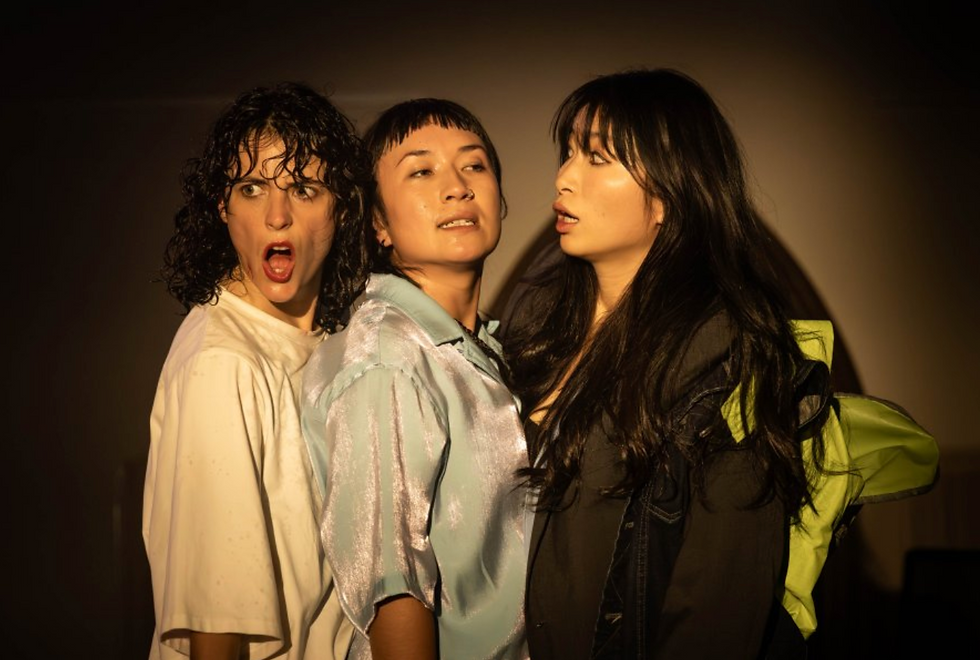Review: Job at Red Stitch Theatre
- Theatre Travels

- Sep 20
- 4 min read
Review by Greg Gorton
Max Wolf Friedlich’s Job has, after a very successful run at Broadway’s Hayes Theatre, come to Australia for the very first time. It is a modern play about technology, mental health, and the darker corners of humanity. Red Stitch Theatre has brought together some of the most successful Australian thespians to bring this play to life, resulting in a competent if underwhelming production. For most audiences, however, this will be remembered as an unsettling production that challenges their view of the world, online and off.
Job is a strong script, though it may not be remembered well in the future. A two-hander, it tells the story of the unhinged social media worker who, when forced to attend a therapy session after a breakdown, instead holds the counsellor hostage. It relies heavily on preachy monologues but, when it focuses on the nature of human relationships and examples that with the two strangers, it produces some powerful scenes. It is far from an evergreen play, but it might perhaps serve as a superficial snapshot of our world today.
In Red Stitch’s production, the small blackbox theatre is transformed into the cramped therapists’ office with quite realistic visuals. From the small plants in the corner to the ergonomic desk chair and laptop computer, the set design screams “modern therapist”. Set designer Jacob Battista also made the costuming choices, which highlight the character choices that have been made and eschews what could have been easy but boring superficial options. The “hippy” therapist is dressed in a wool vest, rather than a hemp jacket, and the young social media woman is in a loose jumper, but not a hoody. This all gives any single vision an air of true authenticity.
Design by David Parker is fascinating in its ability to provide clear, unobtrusive lighting for the majority of the play, which switching into a tech-horror lightscape in those essential second-long moments that break up the realism. A light-strip that haloes the setting is subtle reminder to the audience that this play is always informed by the challenges society faces in a world that cannot be disconnected from the internet.
Being a two hander, though, the play’s success ultimately relies on the two actors and the direction they are given. In this case we have Jessica Clarke and Darren Gilshenan, directed by Nadia Tass. All have long and distinguished careers in theatre, film, and television, and it is not unfair to have expected an incredible production from them.
Gilshenan offers a strong showing as therapist Lloyd. Sometimes fearful, sometimes determined, Gilshenan often allows his stillness to say more than his words. However, it is during the second half of the night (when it would be easy to tire of the endless monologues), that Gilshenan offers a truly powerhouse performance of the key speech of the whole production. It is at this moment that I was most transfixed.
Clarke plays the unhinged Jane with erratic passion. The script calls for us to often question the emotions Jane is experiencing, and appreciate how poorly she is communicating them. Clarke does an amazing job at giving us these questions without making us feel too lost about what is happening.
Having said this about both actors, there were recurring issues that both faced. With the choice of using accents, both performers seem to struggle with offering a vocal range, with Clarke especially unable to present true anger through a monotone (if compelling) voice. The actors also struggled getting into the same timing of conversation, which only highlighted the production’s pacing issues.
While it would be easy to disagree with me, I believe these pacing issues, as well as other struggles I faced, comes down to the directing. In the most part, Nadia Tass appears to have focussed the entirety of her direction on which of the four chairs a character will use during the next monologue, while often treating each monologue-laden section without considering the play as its own. By the fourth ‘scene’, the script might have been unpredictable, but how the characters would act was not.
This production also faced the eternal issue I find in known plays directed by future directors - no real work in considering character intention.
There is a turn in this play, a plot twist, if you will. One could argue that it is a little forced in the script, but I still believe a good director would make it believable. In this production, it was not. And, while they might not have been able to explain it themselves, the audience around me agreed. The words I most heard last night were “I never expected that”, without a single, “well then that makes this early scene easier to understand”.
And this isn’t the only example of forgotten character motivations. The play opens with Jane pulling a gun on Lloyd and the script calls for a regular reminder that she has the gun and is holding Lloyd hostage as he tries to help her. Constantly, though, the production seems to forget about this threat to Lloyd - and I cannot believe that Lloyd himself would.
It’s disappointing that Max Wolf Friedlich’s play didn’t receive the world class performance I know Red Stitch often supplies with its Australian Premieres. However, for a reasonably decent showing of an intriguing little play, it is still worth checking out Job while you can.





